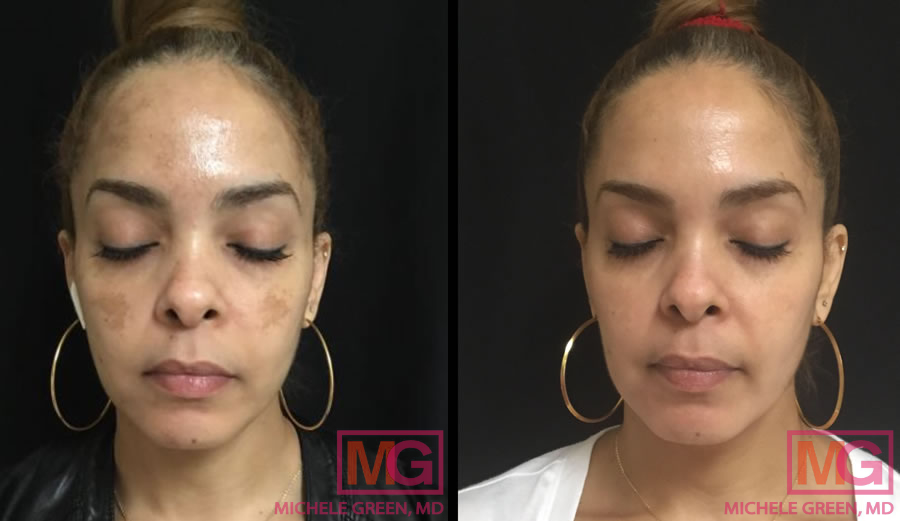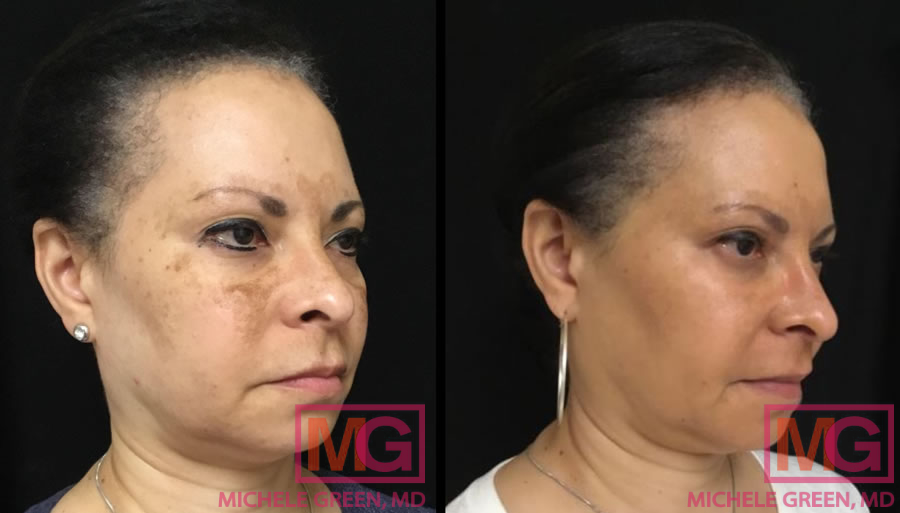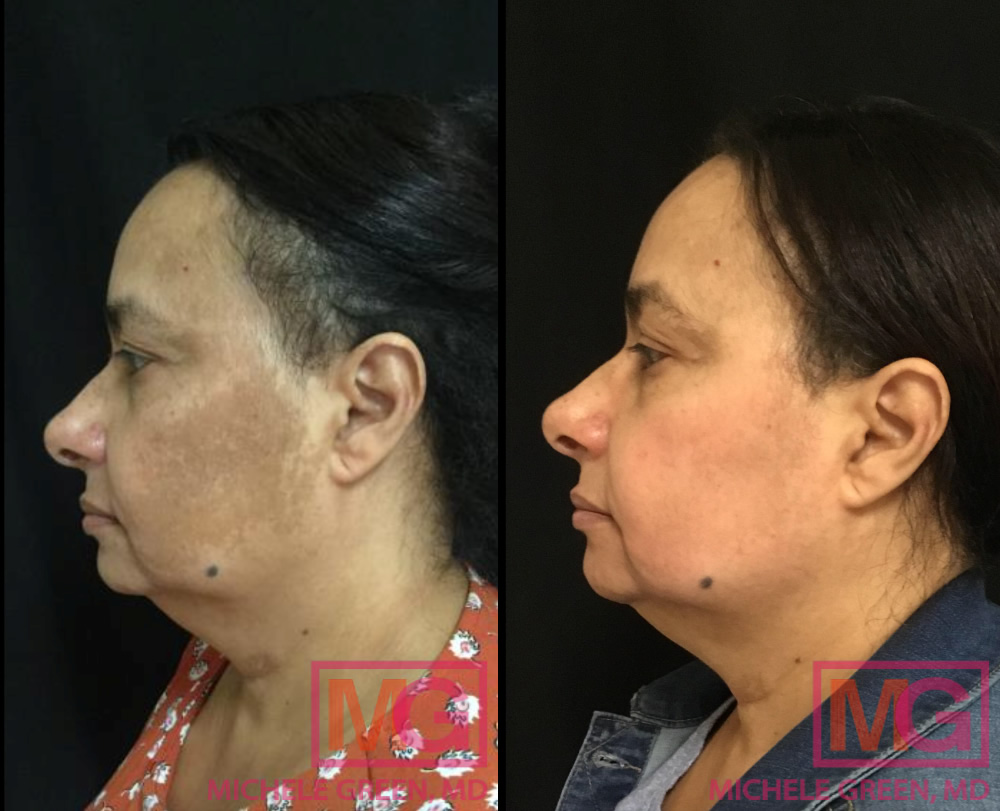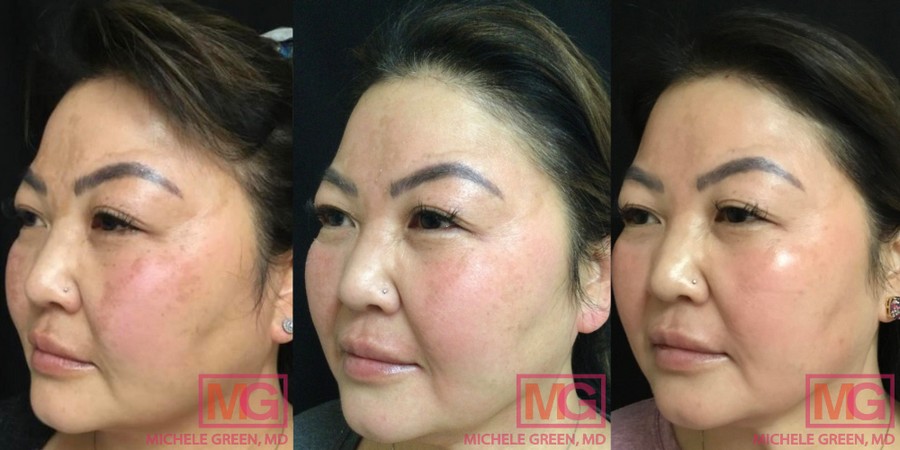Do Chemical Peels Help with Melasma?
Melasma, a skin condition characterized by gray or brown patches that develop on the surface of the skin, can be very upsetting for patients. For many, hyperpigmentation or discoloration on the face can lead to feelings of self-consciousness aesthetically and concern for overall skin health. The trigger for developing the condition can vary from person to person, though common risk factors include too much exposure to harmful UV rays from the sun or tanning beds, hormone fluctuations or genetic factors. The condition is not rare and affects a large percentage of the general population. It is most common in women between the ages of 20 and 40 and those with darker skin types, falling within the IV-VI range on the Fitzpatrick skin type scale. Melasma is also sometimes referred to as the “mask of pregnancy” and between 15 and 50% of pregnant women develop the condition throughout their pregnancy. Concern for appearances or for overall skin health often has patients with melasma looking for a way to rid themselves of the condition. Luckily advancements in dermatology mean that your melasma can be easily treated with the help of chemical peels.
Chemical peels are skin resurfacing treatments that involve the application of a chemical mask. This mask reacts with the dead skin cells present on the outer layer of the skin to gently exfoliate the area. This process triggers the body’s natural healing process, promoting cell turnover for healthier skin. Chemical peels are extremely effective in treating melasma and removing discoloration on the skin. When applied to the affected area, chemical peels work not only to lessen the appearance of hyperpigmentation but also to prevent the accumulation of melanin in the skin, which leads to the discoloration on the skin. For that reason, as long as strict sun avoidance is practiced, chemical peels can help to prevent melasma from occurring again in the future. The process is safe and effective when performed in the office of an expert dermatologist, such as Dr. Michele Green.
Dr. Michele Green has been expertly treating skin conditions of hyperpigmentations, such as facial melasma and post-inflammatory hyperpigmentation in her Upper East Side New York City office for over 25 years. An expert in chemical peels, melasma, skin care, microneedling and laser treatment, Dr. Green has been consistently voted as one of the best dermatologists in NYC by The New York Times, Castle Connolly, Super Doctors, and New York Magazine. Whether it be treating hyperpigmentation as a side effect of lasers, or dark spots and sun spots from excessive sun exposure, or acne marks and acne scars, Dr. Green will help you rejuvenate and lighten your skin. Dr. Green is an expert in treating patients of all skin tones, including Asian patients and dark-skinned patients. If you are suffering from melasma or hyperpigmentation, Dr. Green is here to help.
What is melasma?
Melasma is a skin condition characterized by patches, or lesions, of brown or gray skin that develop most commonly on the face but can also be found on the arms, back, and chest. On the face, most cases of melasma are symmetrical, affecting primarily the forehead, upper lip, bridge of the nose, and cheeks. Melasma is a relatively common condition, however, women are much more likely to suffer from melasma with the American Academy of Dermatology reporting that approximately 90% of instances of the condition are found in women. Specifically, women aged 20 to 40 are most likely to develop the condition. Th incidence is particular high among pregnant women, with melasma affecting between 15 and 50% of all pregnant women. Women who have darker skin tones, such as those that fall in the IV-VI range of the Fitzpatrick scale, are also more likely to be affected by melasma. Patients with lighter skin types can also suffer from the condition but it is often less noticeable for those with lighter skin than for those with darker skin tone.
What causes melasma?
Melasma is caused by an over-activation of the cells that produce melanin in the skin. Melanin is the naturally occurring chemical in your body responsible for pigmentation. Melanin is produced by cells called melanocytes that are found in the epidermal, or outer, layer of the skin. The amount of melanin produced by melanocytes determines the color of your skin. Melasma occurs when the melanocytes in the epidermis are triggered to produce an increased amount of melanin. This overproduction of melanin leads to patches of excessive pigmentation or discoloration in on the surface of the skin. The exact reason for the overproduction of melanin in the melanocytes is not yet definitively known, however, there are a number of risk factors that sometimes lead to this overproduction of melanin, including excessive sun exposure, hormone fluctuations, and genetic predisposition.
What is the best treatment for melasma?
When thinking about the best treatment method for your incidence of melasma, it is very important to consult with a board certified dermatologist, such as Dr. Green. This is especially important if you have a darker skin tone, as many skin lightening products that are used in the treatment of melasma can have harmful effects on dark-skinned patients. Patients with darker skin types are more at risk of developing post-inflammatory hyperpigmentation (PIH) if you receive treatment from someone inexperienced. Dr. Green is highly adept at treating patients with melasma of all skin types and will inform you of all of your treatment options that are safe and effective for you.
At Dr. Green’s office, there are many treatment options for melasma that range from laser treatments, to topical skin care products, to microdermabrasion, to chemical peels. One of most popular and effective treatments for melasma available at Dr. Green’s office is the chemical peel. There are several varieties of chemical peel available, including peels containing glycolic acid, trichloroacetic acid, and hydroquinone. Chemical peels are extremely effective and demonstrate significant improvement to skin discoloration following the treatment process.

Cosmelan: 10 weeks before and after
What is a chemical peel?
There are a wide variety of chemical peels, which work to exfoliate the outer layer of skin (the epidermal layer) to rejuvenate the skin and stimulate the production of collagen for a lighter, brighter look. The chemical peel is applied as a liquid, which can contain a variety of different kinds of acids depending on the type of peel being used. These acids react with the dead skin cells on the surface of the skin in order to exfoliate the outer layer. There are different intensities of chemical peels ranging from superficial peels to deep peels, though when treating melasma, Dr. Green will typically recommend a medium-depth peel. The different types of chemical peels are used to treat a variety of other conditions such as acne scars, and fine lines and wrinkles.
Of all the different varieties of chemical peels available, Dr. Green typically recommends the Cosmelan Peel for her melasma patients. The Cosmelan peel is a professional-grade mask applied by Dr. Green in her office that contains active tyrosinase inhibitors, which work to inhibit the production of melanin in the skin. These ingredients include kojic acid, azelaic acid, arbutine, Phytic Acid, licorice, and ascorbic acid. The two-step process of the Cosmelan Peel, which is extremely safe and effective for all skin types, begins with Cosmelan 1, which is applied in Dr. Green’s office and is used to eliminate the dark spots on the skin. Cosmelan 2 is then applied daily (or twice daily) at home and is meant to prevent the formation of new dark spots and continue to treat existing ones. The Cosmelan 2 is then paired with moisturizers and other skin care products designed to help rejuvenate the skin including Hydra-vital factor K or proprietary products from Dr. Green’s MGSKINLABs, such as the MGSKINLABs Recovery Cream.
How do chemical peels work?
Many patients wonder, do chemical peels work for melasma, and the answer is yes. Chemical peels are topical masks that contain acids that react with the dead skin cells on the surface of the skin in order to exfoliate the skin. Depending on the depth of the peel, the mask can effect just the epidermal – outer – layer of skin or penetrate to the dermal layer of skin. When the acids react with the dead skin cells, it causes the skin to gently peel. The controlled injury to the skin removes the blemishes on the surface of the skin and triggers the body’s healing response, which leads to an increased production of collagen.
When it comes specifically to removing pigmentation on the surface of the skin, a chemical peel such as the Cosmelan Peel works on all levels of dark spot treatment and prevention. When the Cosmelan Peel is initially applied, the active ingredients stimulate skin cell turnover, which removes the melanin that has accumulated in dark patches on the epidermal layer of the skin. The peel then works to inhibit the production of new melanin by blocking the production of melanin in the melanocytes and the movement of melanin between the melanocytes and the keratinocytes. This keeps new dark spots from forming on the service of the skin.
Are chemical peels good for melasma?
Patients often ask, can chemical peels remove melasma, and the answer is yes! Chemical peels are an extremely safe and effective way to eliminate and prevent discoloration on the skin as a result of melasma. Chemical peels work by exfoliating the outer layer of skin and promoting the turnover of skin cells. This eliminates the excessive pigmentation in the treatment area. The acids that make up the chemical peels can also work to inhibit further production of melanin to not only remove the melasma on the skin but prevent the formulation of new dark spots as well.

Cosmelan: 11 months before and after
What type of chemical is best for melasma?
Patients often ask, what is the best chemical peel for melasma, and the answer is: it depends though typically, Dr. Green recommends the Cosmelan Peel to treat melasma. The Cosmelan peel is formulated with retinoids and 51 active ingredients, including kojic acid, azelaic acid, and ascorbic acid and works to eliminate the accumulation of melanin on the skin as well as prevent further accumulation from occurring. There are, however, many varieties of chemical peels that are used to treat melasma that use a variety of different ingredients with different mechanisms of action.
Azelaic acid – Azelaic acid is used as a bleaching agent to lighten skin complexion and address pigmentation conditions such as melasma. Azelaic acid works to block the creation of melanin in over-active melanocyte cells and is safe and effective for all skin types.
Glycolic acid – Glycolic acid peels are a common form of alpha hydroxy acid peel that is effective for the reduction of melasma.
Kojic acid – Kojic acid is a tyrosinase inhibitor, meaning that it works to prevent the production of pigmentation in the skin. Kojic acid is used in the formulation of the Cosmelan peel for the elimination of melasma and is effective to be used on all skin types.
Lactic acid – Lactic acid is also an alpha hydroxy acid that is used in the formulation of chemical peels such as the Jessner peel. Lactic acid is safe to use for all skin types.
Salicylic acid – Salicylic acid is a beta hydroxy chemical that is commonly used in chemical peels for treating acne and acne scars. Commonly, salicylic acid is used in the formulation of Jessner’s solution along with lactic acid and resorcinol. Jessner’s peel is a common superficial chemical peel that is effective for all skin tones. Salicylic acid is also anti-inflammatory, which means that it decreases the likelihood of developing post-inflammatory hyperpigmentation.
Tretinoin – Tretinoin (also known as retinoic acid) can be used to treat acne and sun-damaged skin. Tretinoin is often used to treat surface wrinkles, fine lines, and dark spots.
Trichloroacetic acid – Trichloroacetic acid, found in a trichloroacetic acid or TCA peel, is more commonly used for lighter skin patients as there are risks of significant side effects for patients with darker skin. TCA peels are also not as effective for treating melasma that is non-surface level, meaning melasma that is found in the dermis.
What is the process for getting a chemical peel?
When you are ready to treat you melasma, you will begin by having a consultation appointment with Dr. Green. At your appointment, you should disclose any medications or skin care products that you are using at present. Some medications, contraceptives, and skin care products can exacerbate or worse melasma and as such, part of your treatment recommendation may be changing those medications. Dr. Green will also be able to work with you to determine the treatment or series of treatments that would work best to treat your melasma. Dr. Green is also extremely experienced working with patients of all skin colors and knows the treatments that is safe and effective for patients with lighter skin tones and darker skin tones.
Typically, Dr. Green recommends the Cosmelan Peel to treat melasma as it is very effective and safe for all skin types. The Cosmelan Peel involves a two step process: the first step is for Dr. Green to apply the Cosmelan 1 solution in her office. The amount of time that you should keep the mask on your skin – between 4 and 12 hours – depends on the severity of the melasma condition as well as your skin tone. After the allotted amount of time, you can remove the mask at home with a gentle cleanser. The second part of the treatment is an at-home process. Once or twice a day, you should apply the Cosmelan 2 solution, which helps to prevent new melasma dark spots from forming on the skin. Dr. Green may also prescribe a series of moisturizers or vitamin C solutions in order to further promote skin rejuvenation. Three weeks after your initial appointment, patients should return to Dr. Green’s office in order to receive a touch-up Cosmelan mask to remove any lingering pigmentation.
Chemical peels are a treatment option that requires limited downtime, with only minimal side effects. Some common side effects following the treatment is dryness and irritation at the treatment site, which clear up after several days. The severity of side effects is dependent on how deep the chemical peel is. Following the chemical peel treatment process, it is extremely important that you take the adequate steps for sun protection. While chemical peels work to prevent new production of melanin, melasma can still return if you are further exposed to harmful UV rays from the sun. Dr. Green recommends practicing strict sun avoidance by wearing two types of sunscreen (chemical and physical) of at least SPF 50 or staying inside during the time of day when the sun is at its most intense (from 10am to 2pm).

50-59 year old woman, Cosmelan for Melasma
What are the risk factors for developing melasma?
There are several factors that can increase your risk of developing melasma, which include lifestyle habits, such as too much exposure to the sun, consumption of certain products, as well as biological factors, such as hormone fluctuations or genetics.
Exposure to UV Rays – Ultraviolet rays, also known as UV Rays, can have a harmful effect on the skin when absorbed in too high of quantities. The production of melanin in the skin can be triggered as a way for your body to protect you against these rays. Exposure to UV rays occurs when you spend significant time in direct sunlight or from repeated exposure to tanning beds. In order to decrease risk of developing melasma as a result of UV ray exposure, it is best to avoid tanning beds and wear sunscreen of SPF 50 or higher when going out into the sun.
Hormones – Hormone fluctuations can also be a risk factor for developing melasma. One instance in which this occurs in during pregnancy, which is melasma is sometimes also referred to as the “mask of pregnancy.” Certain hormonal contraceptives, such as the oral birth control pills, can also be a risk factor for developing melasma. If melasma starts to flare up while you are on birth control pills, Dr. Green recommends ceasing your consumption of the contraceptive in order to improve your condition.
Skin Care Products – Over time, certain products can worse or exacerbate melasma. Examples include common exfoliants that are used for conditions such as acne, alpha hydroxy acids, any product that makes your skin more sensitive to sunlight, and soaps that are scented. When you have your initial consultation with Dr. Green, it is important to disclose information on the types of products you are using so she can recommend you discontinue their use if they are exacerbating your condition.
Oral Medication – Some medications that you are prescribed to treat a variety of other conditions may cause photosensitivity, which means that they may cause your skin to be more sensitive to the UV rays from the sun or from tanning beds. If you are taking such medications, you may find that your melasma worsens. Be sure to disclose to Dr. Green the oral medications that you are taking before you begin treatment for melasma so she can make the best recommendation for your wholistic treatment plan. Medications that worse the effects of melasma and/or cause photosensitivity can include certain antibiotics, cardiac medications, and others.
Thyroid Disease – For some patients with melasma, there is a co-morbidity with thyroid disease. For this reason, researchers believe that there could be a link between thyroid disease and melasma, such that those with thyroid disease are at a higher risk of developing melasma.
Are chemical peels good for hyperpigmentation?
Yes! Hyperpigmentation is defined as an area or patch of skin that is darker in pigmentation that the surrounding skin. Melasma is a specific form of hyperpigmentation that can occur on the surface of the skin. Chemical peels are extremely effective in lightening the affected area of skin in order to reduce hyperpigmentation by exfoliating the outer layer of skin and triggering cell turnover. The result is lighter, brighter, healthier-looking skin.
Which is better, laser or chemical peel?
Laser treatments can be used instead of or in addition to chemical peels to treat melasma. Dr. Green employs two types of lasers at her office: the Clear + Brilliant laser and the VBeam laser. These treatments work by exfoliating and resurfacing the skin, which removes the pigmentation and trigger’s the body’s production of new, lighter, brighter skin. When patients ask, which treatment is better, the answer is: it depends. Neither treatment process is inherently better than the other – it all depends on your unique physical goals and needs. When you have your initial consultation with Dr. Green, the two of you will work together to determine the treatment process that is best for you.

Female treated with Cosmelan: 6 weeks
Are chemical peels safe for melasma?
Yes! Chemical peels are extremely safe and effective for eliminating and preventing melasma. That said, it is extremely important to consult with an expert dermatologist, such as Dr. Green, before receiving a chemical peel treatment. Usually, the side effects for chemical peels are mild – skin irritation at the treatment site that dissipates quickly. However, for patients with darker skin, some chemical peels can cause scarring or post-inflammatory hyperpigmentation. It is imperative to use a chemical peel that is safe and effective for all skin types.
Can melasma come back after a chemical peel?
It is possible for melasma to come back after a chemical peel treatment if you are exposed to harmful UV rays following the treatment. For that reason, it is very important to maintain strict sun avoidance following treatment. To do so, Dr. Green recommends wearing two types of sunscreen when you go outside: chemical sunscreen (which contains oxybenzone to absorb and transform the sun’s rays) and physical sunscreen (which contains zinc oxide or titanium dioxide to reflect the sun’s rays). You can also maintain sun avoidance by staying inside when the sun is at its peak intensity, between 10am and 2pm.
How do I get started with chemical peel treatment?
Dr. Michele Green is an expert in chemical peel treatment and effectively treats patients of all skin types, including dark skin tones, at her discreet, private, New York City dermatology office. Whether your hyperpigmentation or melasma is as a consequence of laser treatment, sun exposure, or acne breakouts, Dr. Green is here to help. Dr. Green treats patients of all skin types and will help guide you on the best skin care, sunscreens, and types of chemical peels to improve the discoloration and rejuvenate your skin tone and texture. To find out which chemical peel treatment would be best for you, please call our NYC office at 212 535 3088 or contact us online today.
 212-535-3088
212-535-3088